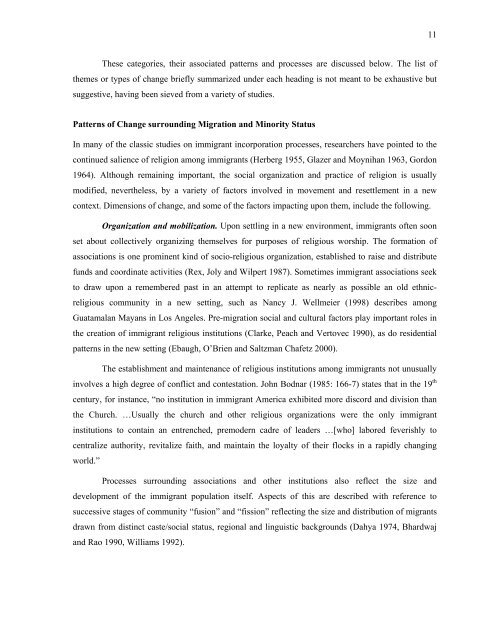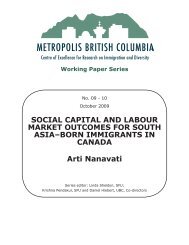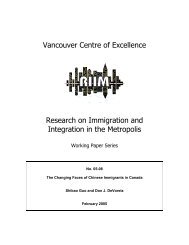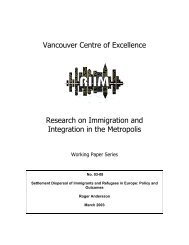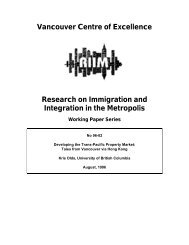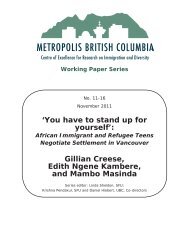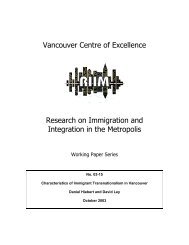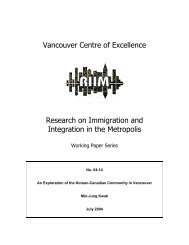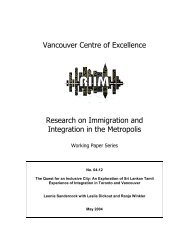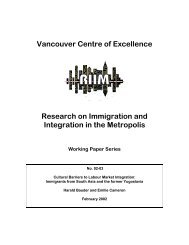Religion in Migration, Diasporas and Transnationalism - Metropolis BC
Religion in Migration, Diasporas and Transnationalism - Metropolis BC
Religion in Migration, Diasporas and Transnationalism - Metropolis BC
You also want an ePaper? Increase the reach of your titles
YUMPU automatically turns print PDFs into web optimized ePapers that Google loves.
11<br />
These categories, their associated patterns <strong>and</strong> processes are discussed below. The list of<br />
themes or types of change briefly summarized under each head<strong>in</strong>g is not meant to be exhaustive but<br />
suggestive, hav<strong>in</strong>g been sieved from a variety of studies.<br />
Patterns of Change surround<strong>in</strong>g <strong>Migration</strong> <strong>and</strong> M<strong>in</strong>ority Status<br />
In many of the classic studies on immigrant <strong>in</strong>corporation processes, researchers have po<strong>in</strong>ted to the<br />
cont<strong>in</strong>ued salience of religion among immigrants (Herberg 1955, Glazer <strong>and</strong> Moynihan 1963, Gordon<br />
1964). Although rema<strong>in</strong><strong>in</strong>g important, the social organization <strong>and</strong> practice of religion is usually<br />
modified, nevertheless, by a variety of factors <strong>in</strong>volved <strong>in</strong> movement <strong>and</strong> resettlement <strong>in</strong> a new<br />
context. Dimensions of change, <strong>and</strong> some of the factors impact<strong>in</strong>g upon them, <strong>in</strong>clude the follow<strong>in</strong>g.<br />
Organization <strong>and</strong> mobilization. Upon settl<strong>in</strong>g <strong>in</strong> a new environment, immigrants often soon<br />
set about collectively organiz<strong>in</strong>g themselves for purposes of religious worship. The formation of<br />
associations is one prom<strong>in</strong>ent k<strong>in</strong>d of socio-religious organization, established to raise <strong>and</strong> distribute<br />
funds <strong>and</strong> coord<strong>in</strong>ate activities (Rex, Joly <strong>and</strong> Wilpert 1987). Sometimes immigrant associations seek<br />
to draw upon a remembered past <strong>in</strong> an attempt to replicate as nearly as possible an old ethnicreligious<br />
community <strong>in</strong> a new sett<strong>in</strong>g, such as Nancy J. Wellmeier (1998) describes among<br />
Guatamalan Mayans <strong>in</strong> Los Angeles. Pre-migration social <strong>and</strong> cultural factors play important roles <strong>in</strong><br />
the creation of immigrant religious <strong>in</strong>stitutions (Clarke, Peach <strong>and</strong> Vertovec 1990), as do residential<br />
patterns <strong>in</strong> the new sett<strong>in</strong>g (Ebaugh, O’Brien <strong>and</strong> Saltzman Chafetz 2000).<br />
The establishment <strong>and</strong> ma<strong>in</strong>tenance of religious <strong>in</strong>stitutions among immigrants not unusually<br />
<strong>in</strong>volves a high degree of conflict <strong>and</strong> contestation. John Bodnar (1985: 166-7) states that <strong>in</strong> the 19 th<br />
century, for <strong>in</strong>stance, “no <strong>in</strong>stitution <strong>in</strong> immigrant America exhibited more discord <strong>and</strong> division than<br />
the Church. …Usually the church <strong>and</strong> other religious organizations were the only immigrant<br />
<strong>in</strong>stitutions to conta<strong>in</strong> an entrenched, premodern cadre of leaders …[who] labored feverishly to<br />
centralize authority, revitalize faith, <strong>and</strong> ma<strong>in</strong>ta<strong>in</strong> the loyalty of their flocks <strong>in</strong> a rapidly chang<strong>in</strong>g<br />
world.”<br />
Processes surround<strong>in</strong>g associations <strong>and</strong> other <strong>in</strong>stitutions also reflect the size <strong>and</strong><br />
development of the immigrant population itself. Aspects of this are described with reference to<br />
successive stages of community “fusion” <strong>and</strong> “fission” reflect<strong>in</strong>g the size <strong>and</strong> distribution of migrants<br />
drawn from dist<strong>in</strong>ct caste/social status, regional <strong>and</strong> l<strong>in</strong>guistic backgrounds (Dahya 1974, Bhardwaj<br />
<strong>and</strong> Rao 1990, Williams 1992).


